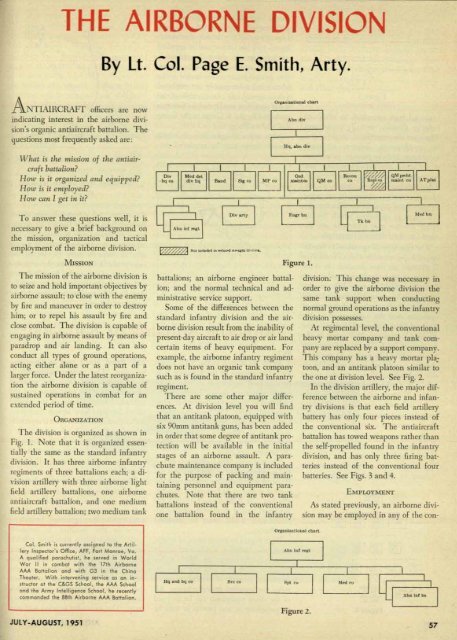July-August - Air Defense Artillery
July-August - Air Defense Artillery
July-August - Air Defense Artillery
Create successful ePaper yourself
Turn your PDF publications into a flip-book with our unique Google optimized e-Paper software.
THE AIRBORNE DIVISION<br />
ANTIAIRCRAFT' officers are now<br />
indicating interest in the airborne division's<br />
organic antiaircraft battalion. The<br />
questions most frequently asked are:<br />
\VlIat is the mission of the antiaircraft<br />
battalion?<br />
How is it organized and equipped?<br />
How is it employed?<br />
How can I get in it?<br />
To answer these questions well, It IS<br />
necessary to give a brief background on<br />
the mission, organization and tactical<br />
employment of the airborne division.<br />
IVhssJON<br />
The mission of the airborne division is<br />
to seize and hold important objectives by<br />
airborne assault; to close with the enemy<br />
by fire and maneuver in order to destroy<br />
him; or to repel his assault by fire and<br />
close combat. The division is capable of<br />
engaging in airborne assault by means of<br />
paradrop and air landing. It can also<br />
conduct all types of ground operations,<br />
acting either alone or as a part of a<br />
larger force. Under the latest reorganization<br />
the airborne division is capable of<br />
sustained operations in combat for an<br />
extended period of time.<br />
ORGANIZATION<br />
The division is organized as shown in<br />
Fig. 1. Note that it is organized essentially<br />
the same as the standard infantry<br />
division. It has three airborne infantry<br />
regiments of three battalions each; a division<br />
artillery with three airborne light<br />
field artillery battalions, one airborne<br />
antiaircraft battalion, and one medium<br />
field artillery battalion; two medium tank<br />
Col. Smith is currently assigned to the Artil.<br />
lery Inspector's Office, AFF, Fort Monroe, Va.<br />
A qualified porachutis~, he served in World<br />
War II in combat with the 17th <strong>Air</strong>borne<br />
AAA Battalion and with G3 in the Chino<br />
Theater. With intervening service as an in.<br />
structor at the C&GS School, the AAA School<br />
and the Army Intelligence School, he recently<br />
commanded the B8th <strong>Air</strong>borne AAA Battalion.<br />
By Lt. Col. Page E. Smith, Arty.<br />
I<br />
B r-I~<br />
b<br />
I<br />
I ~IP ro I<br />
battalions; an airborne engineer battalion;<br />
and the normal technical and administrative<br />
service support.<br />
Some of the differences between the<br />
standard infantry division and the airborne<br />
division result from the inability of<br />
present-day aircraft to air drop or air land<br />
certain items of heavy equipment. For<br />
example, the airborne infantry regiment<br />
does not have an organic tank company<br />
such as is found in the standard infantry<br />
regiment.<br />
There are some other major differences.<br />
At division level you will find<br />
that an antitank platoon, equipped with<br />
six 90mm antitank guns, has been added<br />
in order that some degree of antitank protection<br />
will be available in the initial<br />
stages of an airborne assault. A parachute<br />
maintenance company is included<br />
for the purpose of packing and maintaining<br />
personnel and equipment parachutes.<br />
Note that there are two tank<br />
battalions instead of the conventional<br />
one battalion found in the infantry<br />
~aniu.tionaJ cbart<br />
Abn div<br />
I<br />
B<br />
Figure 1.<br />
OTltsnlzatJonal ('bart<br />
Figure 2.<br />
I<br />
G<br />
EMPWYMENT<br />
Moo hn<br />
division: This change was necessary in<br />
order to give the airborne division the<br />
same tank support when conducting<br />
normal ground operations as the infantry<br />
division possesses.<br />
At regimental level, the conventional<br />
heavy mortar company and tank company<br />
are replaced by a support company.<br />
This company has a heavy mortar pIa:<br />
toon, and an antitank platoon similar to<br />
the one at division level. See Fig. 2.<br />
In the division artillery, the major difference<br />
between the airborne and infantry<br />
divisions is that each field artillery<br />
battery has only four pieces instead of<br />
the conventional six. The antiaircraft<br />
battalion has towed weapons rather than<br />
the self-propelled found in the infantry<br />
division, and has only three firing batteries<br />
instead of the conventional four<br />
batteries. See Figs. 3 and 4.<br />
As stated previously, an airborne division<br />
may be employed in any of the con-<br />
JULY-AUGUST, 1951 57
















